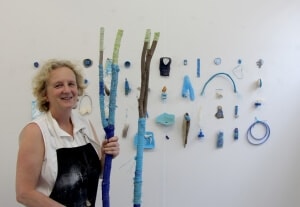In studying for a master’s degree at EIT, Susan Mabin is drawing on her experience of working as an artist in a remote settlement in Iceland’s far north.
Susan completed her Bachelor of Visual Arts and Design at EIT’s ideaschool in 2014. Deciding then on a gap year to take up an artist’s residency overseas, she chose Iceland, a country she first visited in her mid-20s.
“It’s taken me some years to get back there,” she says of the Nordic island, which is celebrated for its striking landscape of glaciers, tundra, lava fields, live volcanoes, geysers and hot springs.
Susan’s 2½ months in Olafsfjordur – “the most isolated town I could find” – was the genesis of a body of work based on man-made and natural objects, which she now largely collects from local beaches but also gathers on walks near her Hastings home.
The finds are from what she characterises as transitional spaces – “the threshold between nature and human habitation.” The material qualities of these odds and ends reveal themselves as she cleans, sorts and photographs them at the end of a day’s fossicking.
“What comes out of this can be as random as the finds themselves,” she says. “The whole process vacillates between the planned and the unplanned, the knowing and not knowing, experimentation and playfulness and also just allowing the materials to be.
“The outcome is unknown, the possible relationships between the re-made objects endless, with the reading of resulting work ultimately reflecting the time and place the original materials are found in.”
The found materials have had past lives, Susan points out, and people bring what they know to their viewing of her assemblages.
“I give the collected materials an aesthetic reading, and if the works are exhibited in a gallery then that changes them again.”
Viewers at Waikato Museum currently have the opportunity to engage with an assemblage Susan calls Random, which is being exhibited up until early December as one of 32 works shortlisted from 260 entries in this year’s National Contemporary Art Award.
It’s a significant achievement for this up and coming artist, who was awarded a prestigious David Fine Memorial Scholarship while studying for her bachelor’s degree and was also named EIT’s top student for creative practice in her graduating cohort.
One of the reasons she decided to enrol in EIT’s newly-launched Master of Professional Creative Practice programme this year was to improve her skills in speaking in public about her work – “to learn to reflect critically on my work and to be able to talk about that”.
Invited to consider her future direction, Susan says her dream scenario would be to work as an artist at different locations around the world.

